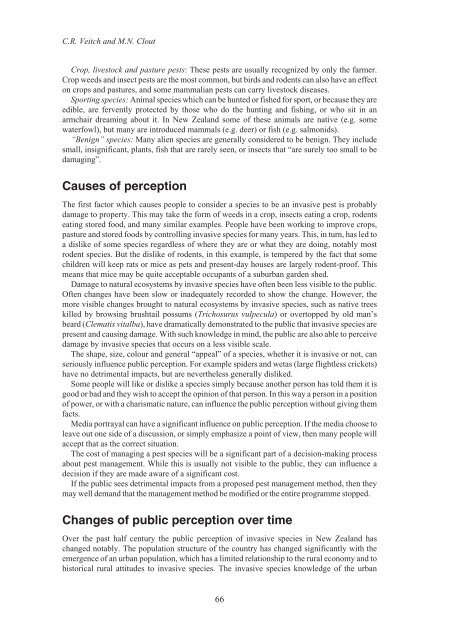Alien Species.vp - IUCN
Alien Species.vp - IUCN
Alien Species.vp - IUCN
Create successful ePaper yourself
Turn your PDF publications into a flip-book with our unique Google optimized e-Paper software.
C.R. Veitch and M.N. Clout<br />
Crop, livestock and pasture pests: These pests are usually recognized by only the farmer.<br />
Crop weeds and insect pests are the most common, but birds and rodents can also have an effect<br />
on crops and pastures, and some mammalian pests can carry livestock diseases.<br />
Sporting species: Animal species which can be hunted or fished for sport, or because they are<br />
edible, are fervently protected by those who do the hunting and fishing, or who sit in an<br />
armchair dreaming about it. In New Zealand some of these animals are native (e.g. some<br />
waterfowl), but many are introduced mammals (e.g. deer) or fish (e.g. salmonids).<br />
“Benign” species: Many alien species are generally considered to be benign. They include<br />
small, insignificant, plants, fish that are rarely seen, or insects that “are surely too small to be<br />
damaging”.<br />
Causes of perception<br />
The first factor which causes people to consider a species to be an invasive pest is probably<br />
damage to property. This may take the form of weeds in a crop, insects eating a crop, rodents<br />
eating stored food, and many similar examples. People have been working to improve crops,<br />
pasture and stored foods by controlling invasive species for many years. This, in turn, has led to<br />
a dislike of some species regardless of where they are or what they are doing, notably most<br />
rodent species. But the dislike of rodents, in this example, is tempered by the fact that some<br />
children will keep rats or mice as pets and present-day houses are largely rodent-proof. This<br />
means that mice may be quite acceptable occupants of a suburban garden shed.<br />
Damage to natural ecosystems by invasive species have often been less visible to the public.<br />
Often changes have been slow or inadequately recorded to show the change. However, the<br />
more visible changes brought to natural ecosystems by invasive species, such as native trees<br />
killed by browsing brushtail possums (Trichosurus vulpecula) or overtopped by old man’s<br />
beard (Clematis vitalba), have dramatically demonstrated to the public that invasive species are<br />
present and causing damage. With such knowledge in mind, the public are also able to perceive<br />
damage by invasive species that occurs on a less visible scale.<br />
The shape, size, colour and general “appeal” of a species, whether it is invasive or not, can<br />
seriously influence public perception. For example spiders and wetas (large flightless crickets)<br />
have no detrimental impacts, but are nevertheless generally disliked.<br />
Some people will like or dislike a species simply because another person has told them it is<br />
good or bad and they wish to accept the opinion of that person. In this way a person in a position<br />
of power, or with a charismatic nature, can influence the public perception without giving them<br />
facts.<br />
Media portrayal can have a significant influence on public perception. If the media choose to<br />
leave out one side of a discussion, or simply emphasize a point of view, then many people will<br />
accept that as the correct situation.<br />
The cost of managing a pest species will be a significant part of a decision-making process<br />
about pest management. While this is usually not visible to the public, they can influence a<br />
decision if they are made aware of a significant cost.<br />
If the public sees detrimental impacts from a proposed pest management method, then they<br />
may well demand that the management method be modified or the entire programme stopped.<br />
Changes of public perception over time<br />
Over the past half century the public perception of invasive species in New Zealand has<br />
changed notably. The population structure of the country has changed significantly with the<br />
emergence of an urban population, which has a limited relationship to the rural economy and to<br />
historical rural attitudes to invasive species. The invasive species knowledge of the urban<br />
66












